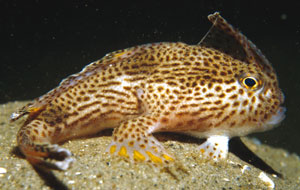Rare Australian fish has fins like hands

The red handfish (pictured below) is one of several species of handfish that live in coastal waters of southeastern Australia. It has quite unusual fins. The front pair of fins look a bit like hands, while the pectoral fins are extended away from the body like arms, ending with a hand-like paddle. The fish pushes against the seabed with these fins to move along in search of food. It is quite capable of swimming quickly if the need arises, but it prefers to stay on the seabed most of the time.
The fish’s motion could be described as ‘walking’, but it is not the same kind of walk as that of land animals. Land animals support most or all of their weight on their legs, which must be strong and heavy-boned to work. But living under water, the handfish’s body weight is mostly carried by its buoyancy, so the fins bear little weight. Their structure is light, well-suited to its way of moving under water.
At least five species of handfish live around Tasmania. The red handfish (Brachionichthys politus) was first described in 1849, being found in the vicinity of the Port Arthur convict settlement. It is small, typically being about 8 cm (3.2 inches) long when fully grown. They live in depths of 2–30 m (6–100 ft). They were once fairly common in that area, but are now rare. Just a few specimens have been collected. Their habitat is quite restricted, as they are only found in a few places along Tasmania’s southeastern coast. They tend to remain in one area, not roaming freely like many other fishes.
The spotted handfish (Brachionichthys hirsutus) is somewhat more common, but even it is only found in a few locations nowadays. Early settlers around Hobart reported them being common, but now they have mostly vanished, and are now considered endangered. Only 20 years ago a book described them as ‘an excellent aquarium specimen’.1 But now their numbers are so low that their location is not publicized, to guard against collection for illegal trade. Reasons given for their decline are loss of habitat, run-off from built-up areas, and particularly the introduction of the Pacific sea star, which eats their eggs.

Handfish are closely related to the better-known anglerfish. Anglerfish also have extended pectoral fins, but their best-known feature is their ‘lure’. Both anglerfish and handfish have a projection on their head, which in anglerfish serves to attract other fish. Smaller fish investigate what looks to them like a tasty morsel, only to find themselves swiftly becoming a meal for the anglerfish. However since handfish eat mostly worms and crustaceans, they do not appear to use their lure in quite the same way. Nevertheless the lure can be lowered or raised, so it may serve to attract prey too.
There is no suggestion that handfish are in any way a ‘missing link’ between fish and animals with legs. The handfish is undoubtedly a fish, with gills and fins, living at the bottom of the sea. So even though it can be said to ‘walk’, that does not mean that it is part-way along some evolutionary path to becoming a land creature. At the beginning God created all the living creatures to reproduce ‘after their kind.’ Handfish have always been handfish just as God said, and their offspring will always be handfish too.
We will do well to conserve this intriguing little creature, and try to keep it from extinction. It is one of the many treasures of God’s creation, over which He has made us stewards.
References
- Last, P.R., Scott, E.O.G. and Talbot, F.H., Fishes of Tasmania, Tasmanian Fisheries Development Authority, Tasmania, p. 250, 1983.
Sources:
Edgar, G.J., Australian marine life, revised edition Reed New Holland, Australia, p. 412, 2000.
Kuiter, RH., Coastal fishes of southeastern Australia, Crawford House Publishing Pty Ltd, Australia, pp. 45–46, 2000. Return to text.




Readers’ comments
Comments are automatically closed 14 days after publication.